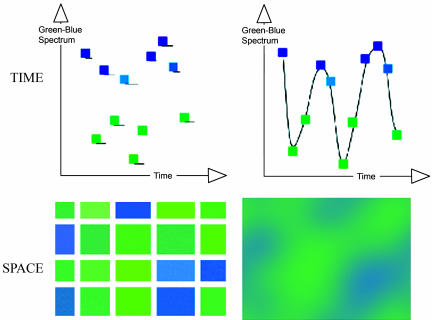Fig. 1.
Schematic view of DART stimuli arranged in a 2 × 2 design. The same hues are used in all conditions. (Upper Left) In the discrete temporal condition, a sequence of blue and green squares appears at random intervals between 150 and 400 ms in the same place on the screen. (Upper Right) In the corresponding analogue temporal condition, the same hues are linked by intermediate hue values, so that a single square appears to be smoothly changing hue. In the corresponding discrete spatial condition (Lower Left), the same hues are formed into discrete rectangles separated by gray background, whereas, in the analogue spatial condition (Lower Right), a smoothing function blurs the boundaries between the different hues. Every trial of discrete stimuli is transformed into a trial of analogue stimuli.

